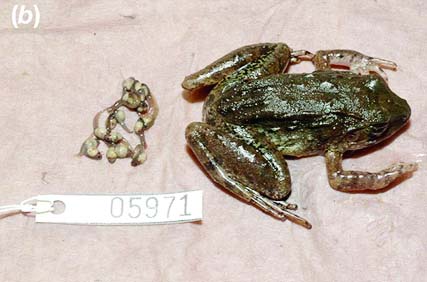
BBC Online :For the first time, frogs have been seen giving birth to tadpoles.Most frogs lay eggs and although some species give birth to froglets, newborn tadpoles are new to science.This species of fanged frog lives on Sulawesi Island in Indonesia, and zoologists had chased it for decades because they suspected it would show this unique behaviour.An international team has now described it for the first time, in a study published in the journal Plos One.Dr Jim McGuire from the University of California, Berkeley, actually thought he was holding a male frog the first time he witnessed a birth.In fact, he had in his hands a pregnant female and, suddenly, a clutch of brand new tadpoles.Nearly all the world’s 6,000 frog species use external fertilisation: the female lays eggs during mating, while the male releases sperm to fertilise them.”But there are lots of weird modifications to this standard mode of mating,” Dr McGuire said.”This new frog is one of only 10 or 12 species that has evolved internal fertilization, and of those, it is the only one that gives birth to tadpoles, as opposed to froglets or laying fertilized eggs.”How the male frogs manage to fertilise eggs inside the female remains a mystery, because frogs have no conventional sexual organs to transfer the sperm.frog eggs Most frogs lay eggs, from which tadpoles eventually hatch Two species found in California have evolved a penis-like “tail” that does the job, but the scientists found no such contrivance on the new Indonesian species.Prof Djoko Iskandar, a collaborator of Dr McGuire’s from the Bandung Institute of Technology in Indonesia, first spotted this new type of fanged frog in the 1990s but they had not been confirmed as a distinct species until now.The scientists called the new species Limnonectes larvaepartus. The Limnonectes family are known as fanged frogs because of twin projections on their lower jaws that are used in fighting.Ben Tapley, team leader of herpetology at the Zoological Society of London (ZSL), said the new finding was “totally out of the blue”.”They’re relatively dull frogs, actually,” Mr Tapley told BBC News. “To find out something totally surprising about a frog you would barely notice in the forest is really cool.”There are thought to be up to 25 species of Limnonectes frogs on Sulawesi, but only four have been described so far – including the new larvaepartus.Little is known about any of the animals’ biology.two tadpoles of the new species The newborn tadpoles are about 1.5cm long”Finding a new species is not that rare – but actually discovering a new reproductive mode is,” Mr Tapley said.”There are more than 40 of these modes in amphibians, but this one is obviously totally unique.”He added that the region where the frog was discovered has one of the highest deforestation rates in the world.”These kind of findings are really valuable, especially in Sulawesi where most of the forest is gone.”It’s great that we’re learning about these species before it’s too late.”

